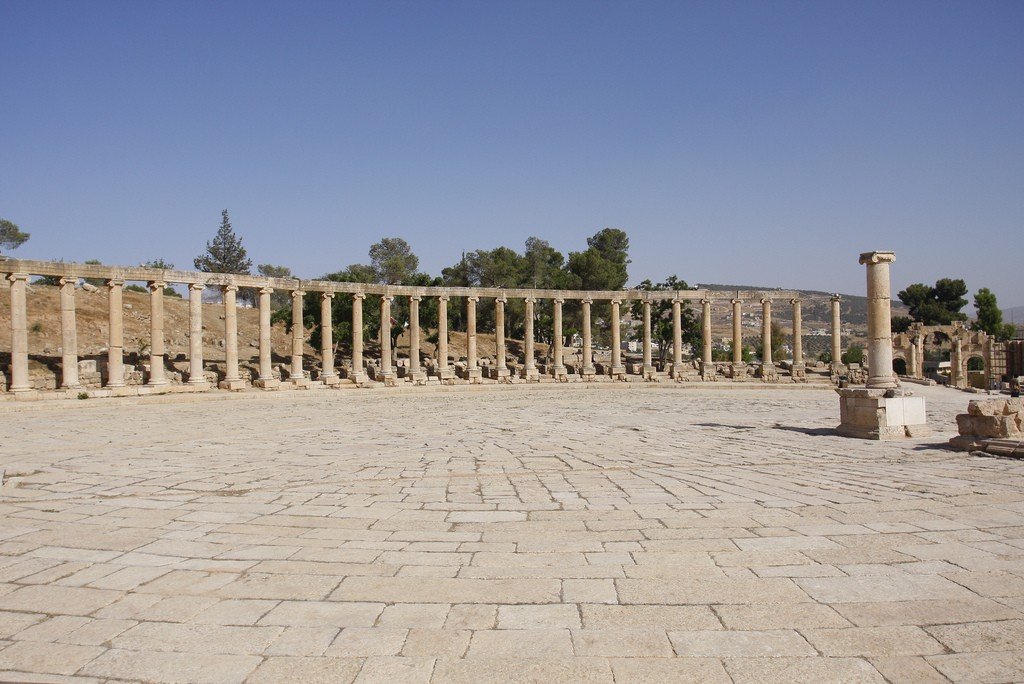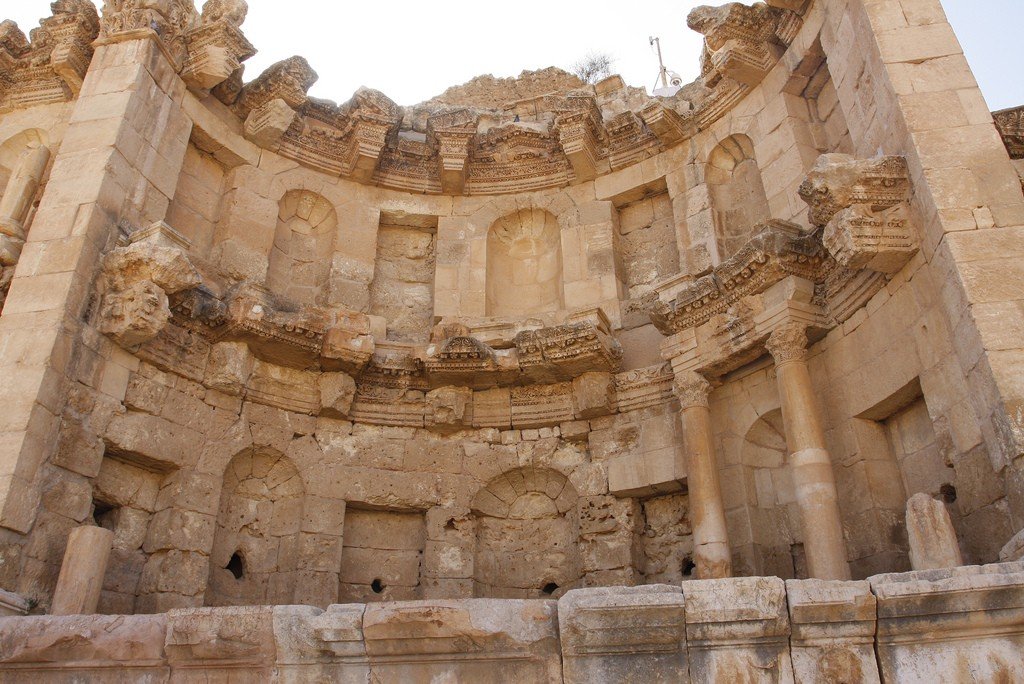Jerash
Jerash (the ancient name was Gerasa) is one of the three great Roman cities (along with Petra and Palmyra, located in the Syrian Desert). Its colonnaded streets, exquisite oval forum, three theaters, two temples, and 15 early Byzantine churches make such a stunning impression that the city has been called the Pompeii of the East.”










General Information
The many beautifully preserved monuments make Jerash unique, but it remains difficult to access and unfortunate in its location. The city is chaotically built in a shallow valley, and here one does not experience the same shock as in Petra at the sight of the facade of the Treasury, nor the romantic elation one gets when walking miles across the desert and seeing the graceful columns of Palmyra rising against the backdrop of an Arab castle. The ruins of Jerash continue to crumble, and only in spring do the flowers give the town a peculiar charm. We recommend visiting Jerash during the annual Summer Festival, when the crowds of tourists help you imagine how crowded this city once was.
.
If you don’t climb the steps of the theater and other buildings, you’ll be walking on flat terrain, but still wear comfortable shoes to avoid tripping over protruding rocks. Shade is rare in Jerash, so choose a time to walk so you don’t get caught in the sun’s scorching rays during the hottest months. There is a hotel in town, with restrooms at the entrance. The walk is about 3 kilometers long. It will take at least two hours.
.Open: 8.00-16.00 (winter), 8.00-19.00 (summer). Entrance is paid.
.Excavations
When the first Western travelers accidentally discovered this town in the early 19th century, they found it in picturesque desolation: the streets were overgrown with grass, the columns had fallen down. In 1878 Circassian Muslims – refugees from Russia – at the behest of the Ottoman Sultan Abdul Hamid II settled in the valley and used stones from the ruins to build their own houses. The eastern part of the Roman Jerash disappeared, giving way to the so-called New City. Excavations continued throughout the XX century, they were carried out by archaeologists from Britain, Germany, the United States and the Department of Antiquities of Jordan. The Germans were particularly successful, discovering in 1907 a beautiful Roman mosaic depicting mythological scenes, the best of those found in Jerash. It was sent by sea to Germany and more than 50 years later was placed in the vault of Berlin’s Pergamon Museum. It is now on display there.
.Wealth of the Romans
Although there was already a Hellenistic city here in the 4th century BC, everything that survives today dates back to the Roman era. Gerasa was conquered by the Roman Empire in 84 BC, and Pompey, dividing his possessions into provinces, included it in the province of Syria. In fact, self-government flourished here, and the city eventually became part of the Decapolis, a union of ten free cities. Trade and agriculture flourished under Roman rule, and by the 2nd century AD the city had accumulated so much wealth that it was rebuilt, as it is today. The city walls have been preserved for 3.5 kilometers, encircling the city in a ring. The Roman population was estimated at 15,000. The Ionic columns on the oval forum were painted in red, yellow, blue and green colors – an original idea. Along the Via Cardo Maximus stood 260 Corinthian columns on each side, and potholes from chariot wheels on the stone sidewalk can still be seen.
.What to see
Hadrian’s Gate
This beautiful triumphal arch was erected in 129 AD on the occasion of Emperor Hadrian’s visit to the city. Three vaulted arches mark the beginning of the old road that led to the main city gate, the South Gate. Theaters, temples, a forum and baths all date back to a time when the region flourished thanks to Rome’s stable prosperity. Go through the archway, past the hippodrome (on the left) to emerge to the hotel and the South Gate.
.Oval forum
This jewel of Jerash is the first thing you see when the road comes out into the open. Its unusual shape has led researchers to speculate that sacrifices were offered here in front of the temple of Zeus, and it was only later that a market square appeared. After seeing the Temple of Zeus and the theater, exit the Forum onto Via Cardo Maximus, walk past the small museum on the right, past several intersections and walk to the Cathedral (it is about 400 m away).
.Cathedral
This cathedral, which is reached by a wide staircase, was built in the middle of the 4th century. In its heyday, Jerash boasted fifteen churches, most of them centered around the cathedral. Follow the path through the Fountain Court to St. Theodore’s Church.
.Churches
Note the mosaic floors in the churches; the most beautiful is in the church of St. Cosmas and Damian, and can be seen by looking behind a high wall. There are also fragments of mosaics in the churches of St. George and St. John the Baptist. Return to the church of St. Theodore, then turn left onto the path leading to the bulky plinth of the Temple of Artemis.
.Temple of Artemis
This is the most impressive of Jerash’s structures in all its integrity and power, as the temple is dedicated to the city’s patron goddess. It is a cluster of staircases, gates and courtyards. Exit the temple to the north, towards the theater; from here you will only have to descend. Return to Cardo Maximus past the propylaea (entrance) of the temple and make your way to the Nympheum (on the right).
.Nympheum
.The fountain’s two-story monumental facade is elaborately decorated; the huge stone pool is also very beautiful. Return to the ticket office, walking straight ahead the whole time.
.
